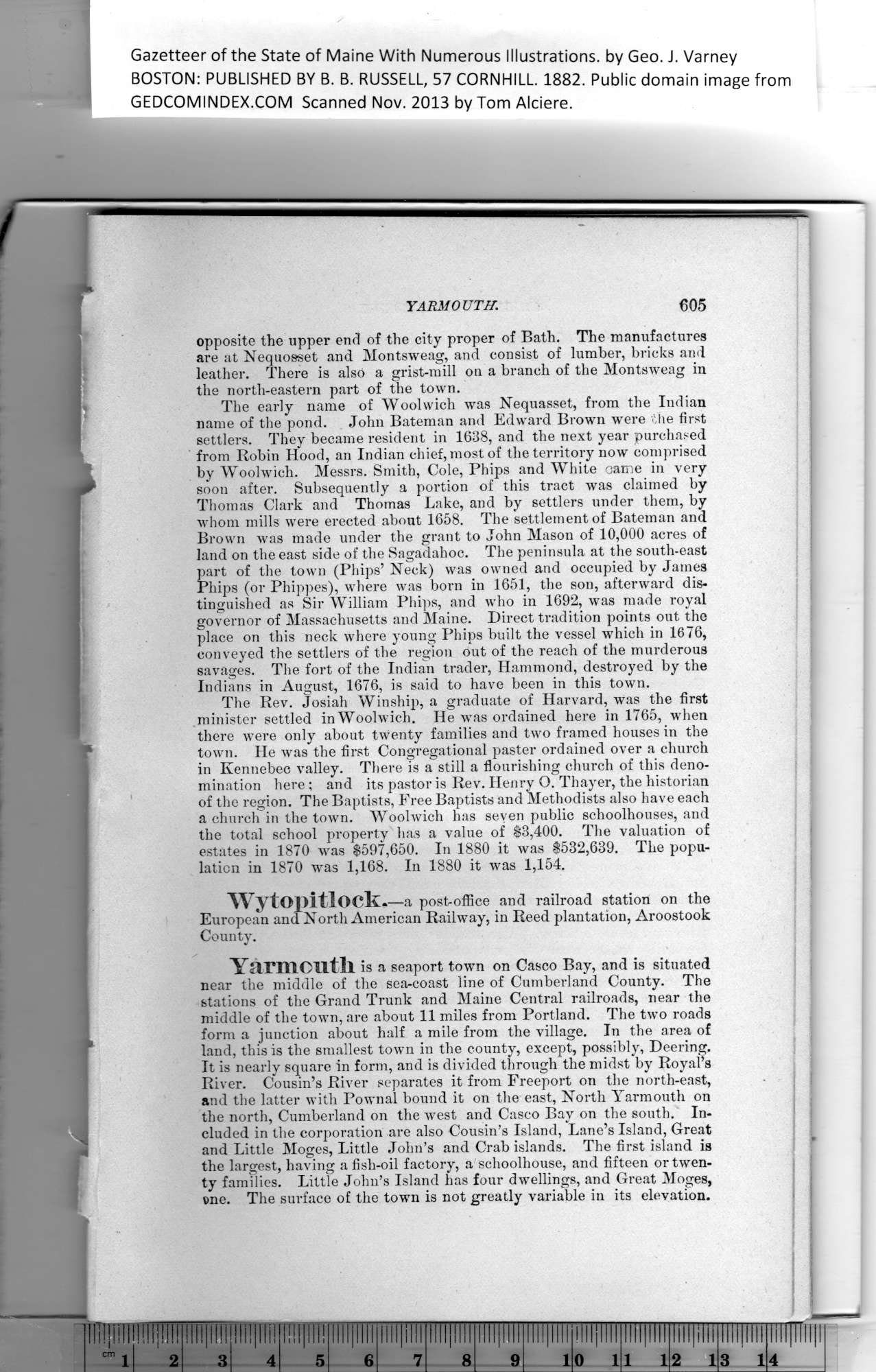|
Gazetteer of the State of Maine With Numerous Illustrations, by Geo. J. Varney
BOSTON: PUBLISHED BY B. B. RUSSELL, 57 CORNHILL. 1882. Public domain image from
YARMOUTH. 605
opposite the upper end of the city proper of Bath. The manufactures
are at Nequosset and Montsweag, and consist of lumber, bricks and
leather. There is also a grist-mill on a branch of the Montsweag in
the north-eastern part of the town.
The early name of Woolwich was Nequasset, from the Indian
name of the pond. John Bateman and Edward Brown were the first
settlers. They became resident in 1638, and the next year purchased
from Robin Hood, an Indian chief, most of the territory now comprised
by Woolwich. Messrs. Smith, Cole, Phips and White came in very
s soon after. Subsequently a portion of this tract was claimed by
Thomas Clark and Thomas Lake, and by settlers under them, by
whom mills were erected about 1658. The settlement of Bateman and
Brown was made under the grant to John Mason of 10,000 acres of
land on the east side of the Sagadahoc. The peninsula at the south-east
part of the town (Phips’ Neck) was owned and occupied by James
Phips (or Phippes), where was born in 1651, the son, afterward dis-
tinguished as Sir William Phips, and who in 1692, was made royal
governor of Massachusetts and Maine. Direct tradition points out the
place on this neck where young Phips built the vessel which in 1676,
conveyed the settlers of the region out of the reach of the murderous
savages. The fort of the Indian trader, Hammond, destroyed by the
Indians in August, 1676, is said to have been in this town.
The Rev. Josiah Winship, a graduate of Harvard, was the first
minister settled inWoolwich. He was ordained here in 1765, when
there were only about twenty families and two framed houses in the
town. He was the first Congregational paster ordained over a church
in Kennebec valley. There is a still a flourishing church of this deno-
mination here; and its pastor is Rev. Henry O. Thayer, the historian
' of the region. The Baptists, Free Baptists and Methodists also have each
a church in the town. Woolwich has seven public schoolhouses, and
the total school property has a value of $3,400. The valuation of
estates in 1870 was $597,650. In 1880 it was $532,639. The popu-
lation in 1870 was 1,168. In 1880 it was 1,154.
Wytopitlock.—a post-office and railroad station on the
European and North American Railway, in Reed plantation, Aroostook
County.
Yarmouth is a seaport town on Casco Bay, and is situated
near the middle of the sea-eoast line of Cumberland County. The
stations of the Grand Trunk and Maine Central railroads, near the
middle of the town, are about 11 miles from Portland. The two roads
form a junction about half a mile from the village. In the area of
land, this is the smallest town in the county, except, possibly, Deering.
It is nearly square in form, and is divided through the midst by Royal’s
River. Cousin’s River separates it from Freeport on the north-east,
and the latter with Pownal bound it on the east, North Yarmouth on
the north, Cumberland on the west and Casco Bay on the south. In-
cluded in the corporation are also Cousin’s Island, Lane’s Island, Great
and Little Moges, Little John’s and Crab islands. The first island is
the largest, having a fish-oil factory, a schoolhouse, and fifteen or twen-
ty families. Little John’s Island has four dwellings, and Great Moges,
one. The surface of the town is not greatly variable in its elevation.
PREVIOUS PAGE ... NEXT PAGE
This page was written in HTML using a program written in Python 3.2
|
